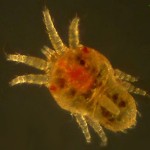The flat mite
 Representatives of the Tenuipalpidae species are close relatives of spider mites, fact for which they are called false spider mites. The main anatomical difference between these two species is the shape of the body. The spider mite has a whole body, while the flat mite has a body divided transversely into three parts (the front side, middle and back).
Representatives of the Tenuipalpidae species are close relatives of spider mites, fact for which they are called false spider mites. The main anatomical difference between these two species is the shape of the body. The spider mite has a whole body, while the flat mite has a body divided transversely into three parts (the front side, middle and back).
Around 40 representatives of this species are known , which damages especially the vine crops, citrus fruits, palm, Roses, ficuses and many other tropical and subtropical plants. Flower growers meet with two species of flat mites: Brevipalpus and Tenuipalpus. Brevipalpus russilus mite is a feared pest for cacti, instead, Tenuipalpus affects orchids and ferns. Pests of orchids are also mites Brevipalpus oncidii and Brevipalpus obovatus.
In more detail I will talk about the mite Brevipalpus obovatus, He is the main pest of African violets. This mite is also known as the red flat mite, flat orange mite, common flat mite, etc.
They are tiny mites. Their size is 0.3 x 0.18 mm. The body is oval, strongly flattened, red or reddish color, covered with short hairs;.
The male is smaller in size than the female. Females can also lay unfertilized eggs, from which females will subsequently emerge. The eggs are purple in color and have luster. Their size is about 0.1mm.
Larvae of red mite are purple in color, They have 3 pairs of legs and are a bit larger than the egg. After the first stage of development, They turn into protonymphs, who like adults, They have 4 pairs of legs and differ from adults only in size. These being a bit smaller.
After each stage of development, The flat mite is in hibernation. Hibernation periods occupy 40% of the development period of the flat mite. Usually, hibernates females and eggs.
Being in hibernation, the flat mite does not feed and successfully endures low temperatures, Because of this, many preparations used to destroy it do not work.
The flat mite populates predominantly on the upper part of the leaves of African violets, feeding on cellular juice. It is impossible to see with the naked eye.
The leaves of the African violets affected by the flat mite have edges bent downwards, especially when the air humidity is low. The traces left by the flat mite are best seen on the leaves located near the root. Affected plants lose their decorativeness, decrease the surface area and intensity of photosynthesis, no longer bloom, The affected leaves quickly wither and easily detach from the stem, The plant stagnates from growth. Plus everything, Violets become susceptible to infection and can easily die.
On streptocarpus flat mite manifests itself somewhat differently. Carefully researching the underside of the leaf, In the cells between the veins there is a luster specific to an oil stain. The leaf surface in these places becomes embossed and acquires a brownish color. The leaf gradually acquires a yellowish tint and begins to dry from the edges.

The flat mite hibernates during certain periods of time, lasting 3-4 days followed by equally short feeding periods. Because of this, more chemical treatments are required, performed at short intervals from each other.
Effective combat can be done with acaricides and insecto-acaricides: VERMITEC, FITOVERM, NEORON, DEMITAN, OMIT, SUNMITE, NISSORUN, SAFRAN, ENVIDOR, MILBEKNOCK, MITIGAN, TALSTAR etc.. The preparations should be used according to the recommendations on the label.
It should be taken into account that they do not destroy eggs, Larvae, protonymphs and hibernating females.
Treating the plant once will decrease the number of parasites, but not their complete destruction. These preparations do not work if the room temperature is below + 18 °C, and solutions prepared from them are stored no more than a day.
Treatment of the plant is carried out 3-4 times at intervals of 3-4 days.
The best preparation in the destruction of this parasite is APOLLO 50 SC. It is relatively harmless to human health and destroys the flat mite even at the stage of embryonic development.
Avoid using Actelic in apartments. The sprayed solution evaporates and gives off poisonous fumes that endanger the lives of the occupants.

